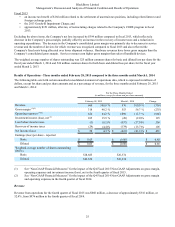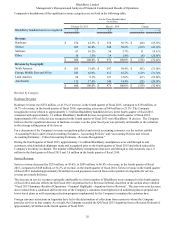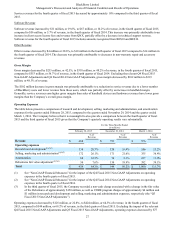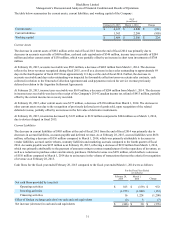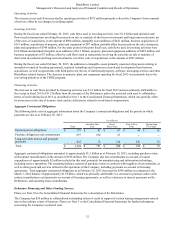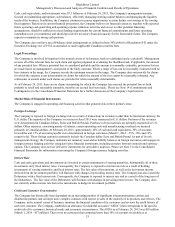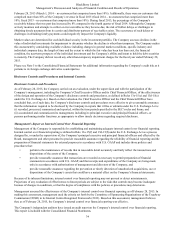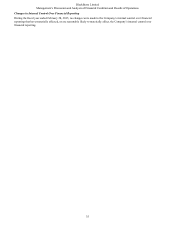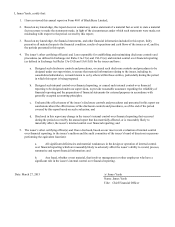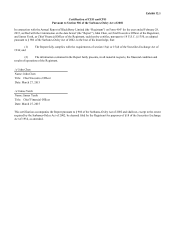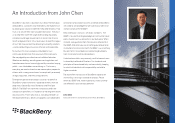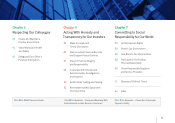Blackberry 2015 Annual Report Download - page 145
Download and view the complete annual report
Please find page 145 of the 2015 Blackberry annual report below. You can navigate through the pages in the report by either clicking on the pages listed below, or by using the keyword search tool below to find specific information within the annual report.BlackBerry Limited
Management’s Discussion and Analysis of Financial Condition and Results of Operations
34
February 28, 2015 (March 1, 2014 – no customers that comprised more than 10%). Additionally, there were no customers that
comprised more than 10% of the Company’s revenue in fiscal 2015 (fiscal 2014 – no customers that comprised more than
10%; fiscal 2013 – no customers that comprised more than 10%). During fiscal 2015, the percentage of the Company's
receivable balance that was past due increased by 8% compared to the fourth quarter of fiscal 2014. Although the Company
actively monitors and attempts to collect on its receivables as they become due, the risk of further delays or challenges in
obtaining timely payments from its carrier and distributor partners of receivables exists. The occurrence of such delays or
challenges in obtaining timely payments could negatively impact the Company's liquidity.
Market values are determined for each individual security in the investment portfolio. The Company assesses declines in the
value of individual investments for impairment to determine whether the decline is other-than-temporary. The Company makes
this assessment by considering available evidence including changes in general market conditions, specific industry and
individual company data, the length of time and the extent to which the fair value has been less than cost, the financial
condition, the near-term prospects of the individual investment and the Company’s ability and intent to hold the debt securities
to maturity. The Company did not record any other-than-temporary impairment charges for the fiscal year ended February 28,
2015.
Please see Note 5 to the Consolidated Financial Statements for additional information regarding the Company's credit risk as it
pertains to its foreign exchange derivative counterparties.
Disclosure Controls and Procedures and Internal Controls
Disclosure Controls and Procedures
As of February 28, 2015, the Company carried out an evaluation, under the supervision and with the participation of the
Company’s management, including the Company’s Chief Executive Officer and its Chief Financial Officer, of the effectiveness
of the design and operation of the Company’s disclosure controls and procedures, as defined in Rules 13a-15(e) and 15d-15(e)
under the U.S. Exchange Act. Based on that evaluation, the Chief Executive Officer and the Chief Financial Officer have
concluded that, as of such date, the Company’s disclosure controls and procedures were effective to give reasonable assurance
that the information required to be disclosed by the Company in reports that it files or submits under the U.S. Exchange Act is
(i) recorded, processed, summarized and reported, within the time periods specified in the SEC’s rules and forms, and
(ii) accumulated and communicated to management, including its principal executive and principal financial officers, or
persons performing similar functions, as appropriate to allow timely decisions regarding required disclosure.
Management’s Report on Internal Control Over Financial Reporting
Management of the Company is responsible for establishing and maintaining adequate internal control over financial reporting.
Internal control over financial reporting is defined in Rule 13a-15(f) and 15d-15(f) under the U.S. Exchange Act as a process
designed by, or under the supervision of, the Company’s principal executive and principal financial officers and effected by the
Board, management and other personnel to provide reasonable assurance regarding the reliability of financial reporting and the
preparation of financial statements for external purposes in accordance with U.S. GAAP and includes those policies and
procedures that:
• pertain to the maintenance of records that in reasonable detail accurately and fairly reflect the transactions and
dispositions of the assets of the Company;
• provide reasonable assurance that transactions are recorded as necessary to permit preparation of financial
statements in accordance with U.S. GAAP, and that receipts and expenditures of the Company are being made
only in accordance with authorizations of management and directors of the Company; and
• provide reasonable assurance regarding the prevention or timely detection of unauthorized acquisitions, use or
dispositions of the Company’s assets that could have a material effect on the Company’s financial statements.
Because of its inherent limitations, internal control over financial reporting may not prevent or detect misstatements.
Projections of any evaluation of effectiveness to future periods are subject to the risks that controls may become inadequate
because of changes in conditions, or that the degree of compliance with the policies or procedures may deteriorate.
Management assessed the effectiveness of the Company’s internal control over financial reporting as of February 28, 2015. In
making this assessment, management used the criteria set forth by the Committee of Sponsoring Organizations of the Treadway
Commission (COSO) in its Internal Control-Integrated Framework (2013). Based on this assessment, management believes
that, as of February 28, 2015, the Company’s internal control over financial reporting was effective.
The Company’s independent auditors have issued an audit report on the Company’s internal control over financial reporting.
This report is included with the Consolidated Financial Statements.



